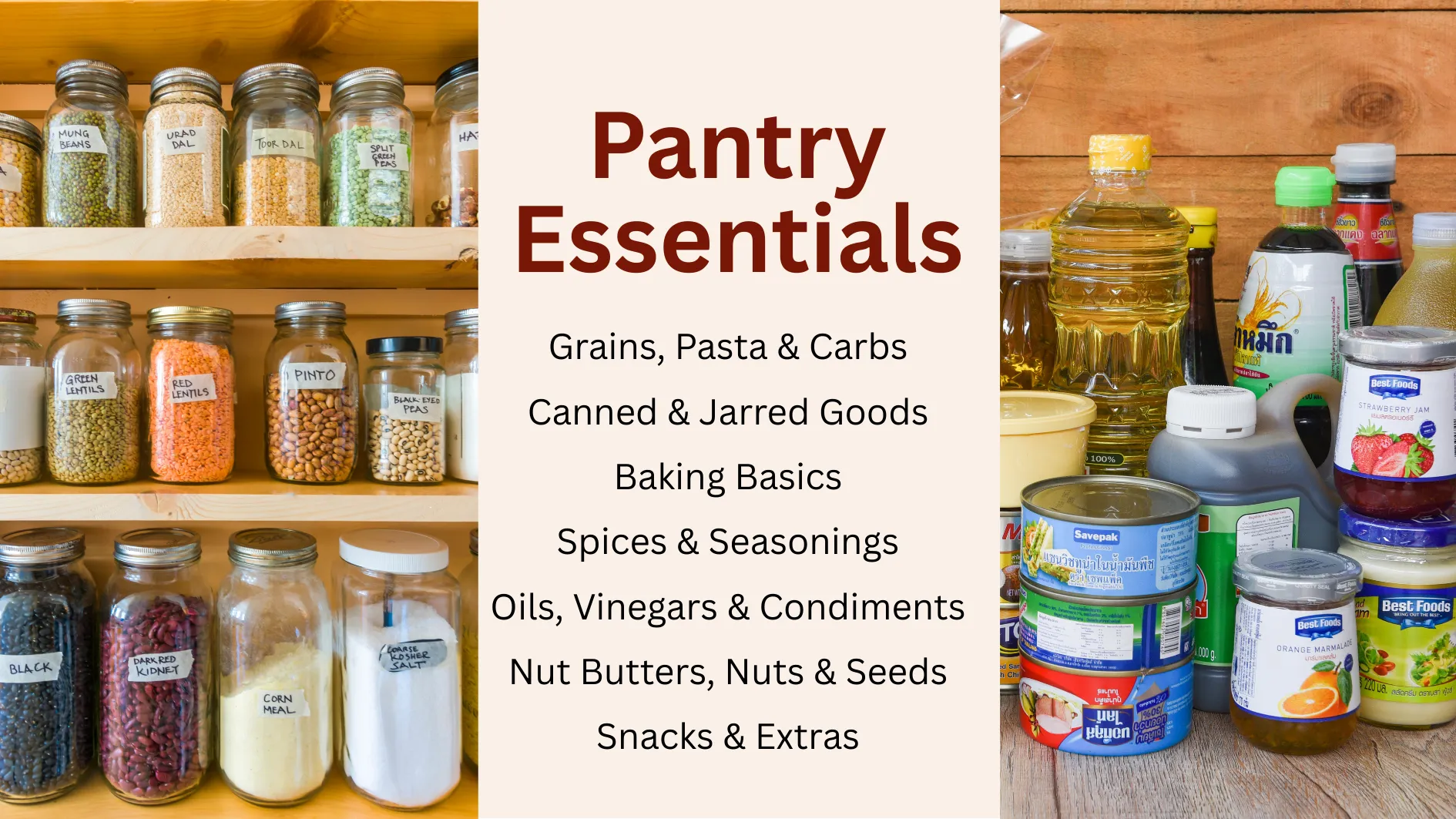Whether you’re learning to cook for the first time or stocking a new kitchen, building a smart, reliable pantry is one of the best things you can do to make everyday cooking easier and more enjoyable. A well-stocked pantry gives you the flexibility to whip up meals on short notice, try new recipes with confidence, and avoid unnecessary trips to the store.
In this beginner-friendly guide, we’ll break down the essential pantry ingredients you should always have on hand, including spices, grains, canned goods, baking basics, and more. Let’s stock your kitchen for success!
Grains, Pasta & Carbs
Grains and starchy staples are the backbone of countless meals across every cuisine. They provide affordable, filling, and versatile options that every new cook should keep stocked in their pantry. Whether you’re whipping up a quick stir-fry, assembling a burrito, or baking your own granola, these pantry heroes are essential.
1. Rice
A true staple across the world, rice is the foundation of everything from fried rice and stir-fries to rice bowls and casseroles. Keep a few types on hand to suit your cooking style:
- White rice: Quick-cooking and neutral-flavored.
- Brown rice: Nutty, higher in fiber, and great for whole-grain meals.
- Jasmine or basmati: Fragrant varieties perfect for Asian or Indian dishes.
💡 Pro tip: Store rice in an airtight container in a cool, dry place to keep it fresh and prevent pantry pests.
2. Pasta
Dried pasta is a lifesaver on busy nights. It cooks in minutes and pairs with virtually anything, marinara, pesto, stir-fried veggies, or a simple garlic and olive oil sauce.
- Stock a few shapes like spaghetti, penne, or fusilli to add variety.
- Pair with canned sauces, sautéed veggies, or leftover proteins for instant meals.
3. Quinoa or Couscous
These quick-cooking grains are fantastic for salads, grain bowls, and as side dishes.
- Quinoa is packed with protein and cooks in 15 minutes.
- Couscous is even faster, just pour hot water and let it steam.
Both are light, fluffy, and absorb flavors beautifully, making them great for meal prep.
4. Rolled Oats
Not just for breakfast, oats are a pantry MVP:
- Cook into a warm morning porridge
- Blend into smoothies for thickness
- Bake into cookies, muffins, or homemade granola
- Use in savory recipes like oat-crusted chicken or veggie patties
💡 Pro tip: Choose old-fashioned rolled oats for the most versatility. Store in a lidded container to prevent moisture and pests.
5. Breadcrumbs or Panko
Perfect for breading proteins, topping casseroles, or bulking up meatballs. Keep both regular breadcrumbs and panko (Japanese-style, extra-crispy) on hand for texture variety.
- Use as a crunchy topping for baked mac and cheese or veggie gratins.
- Toast in a pan with garlic and herbs for an easy pasta topper.
6. Tortillas or Flatbreads
These flexible staples are ideal for wraps, tacos, quick pizzas, and even breakfast burritos.
- Flour tortillas store well in the fridge or freezer.
- Flatbreads like naan or pita can be used for dips, sandwiches, or grilled snacks.
💡 Pro tip: Freeze extra packs and thaw one at a time, they warm quickly in the microwave or on a skillet.
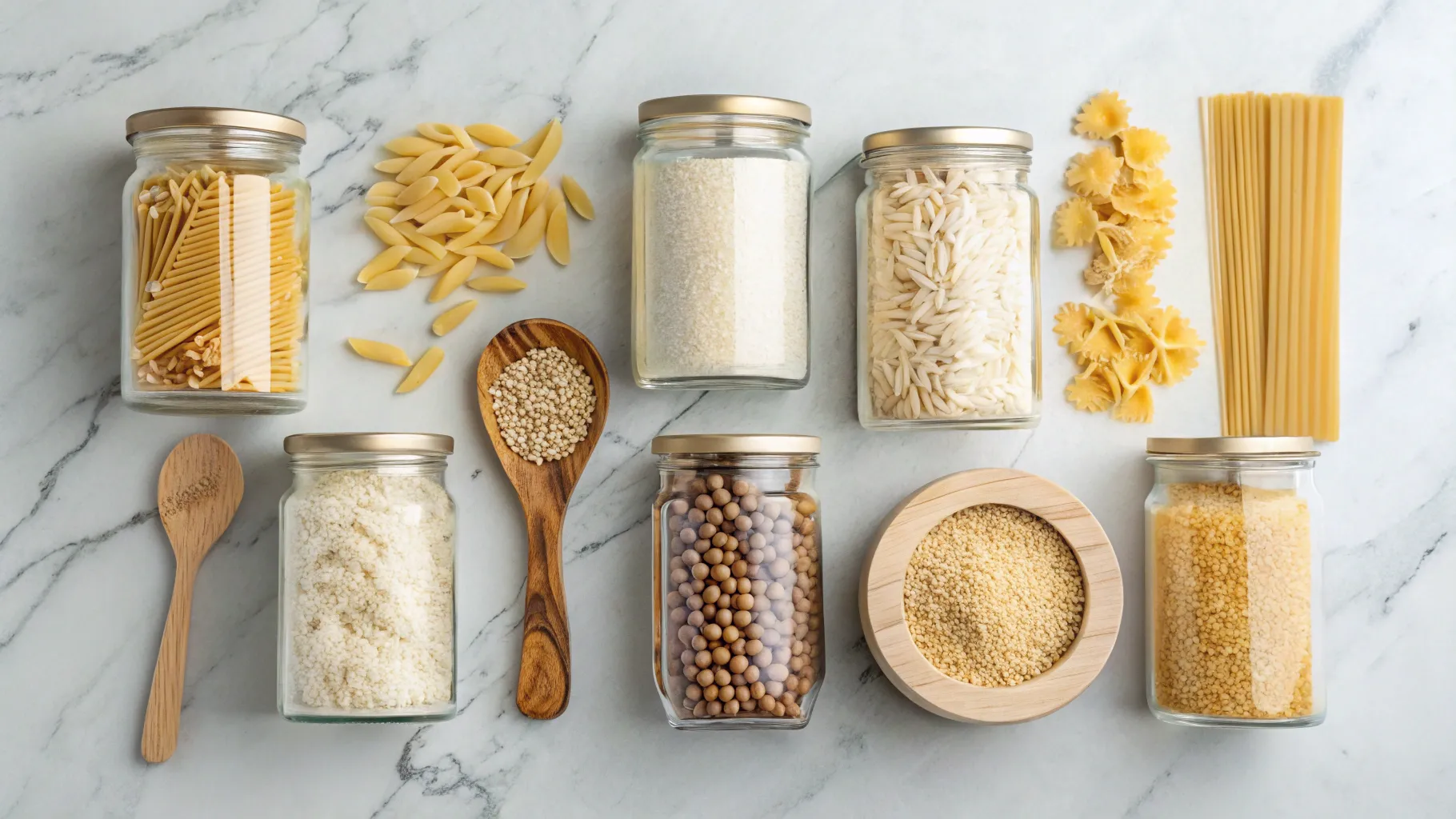
Canned & Jarred Goods
When you’re just starting out in the kitchen, canned and jarred ingredients are your best friends. These pantry staples are budget-friendly, long-lasting, and ready to use, perfect for quick meals and minimal prep. With just a few cans or jars, you can build soups, stews, pasta dishes, salads, or grain bowls in minutes.
Let’s take a closer look at the must-have canned and jarred items every beginner cook should stock:
1. Canned Beans
Beans are a powerful source of plant-based protein, fiber, and nutrients. They’re filling, affordable, and endlessly versatile:
- Black beans: Ideal for tacos, burrito bowls, and chili.
- Chickpeas (garbanzo beans): Great for salads, roasting, or blending into hummus.
- Kidney beans: Perfect in hearty stews or red beans and rice.
- White beans (cannellini, navy, or great northern): Creamy and mild — perfect for soups, pastas, and dips.
💡 Pro tip: Always rinse canned beans under cold water to remove excess sodium and improve flavor.
2. Canned Tomatoes
No pantry is complete without tomatoes, they’re the base for countless dishes:
- Diced or crushed tomatoes: Use in pasta sauces, soups, stews, or shakshuka.
- Whole peeled tomatoes: Break up by hand or in a blender for homemade sauces.
- Tomato paste (optional): Adds rich flavor in a concentrated form, great for building depth in sauces, chili, or braises.
💡 Pro tip: Transfer leftovers from opened cans into a container and refrigerate, never store food in an open metal can.
3. Coconut Milk
Creamy and slightly sweet, coconut milk is a staple in Asian, Caribbean, and Indian cooking.
- Use in curries, soups, sauces, and smoothies.
- Great base for creamy vegan dishes or desserts.
Light coconut milk is also available if you’re watching fat content.
4. Canned Tuna or Salmon
Canned fish is a quick and easy source of lean protein and omega-3s.
- Mix with mayo, mustard, or yogurt for quick tuna salad.
- Stir into pasta, serve over rice, or pile on toast.
- Canned salmon is excellent for patties, salads, or hearty grain bowls.
💡 Pro tip: Look for varieties packed in water or olive oil depending on your preference.
5. Jarred Pasta Sauce
When you need a quick meal, jarred sauce comes to the rescue:
- Toss with cooked pasta and top with cheese or herbs.
- Use as pizza sauce on flatbreads or pita.
- Simmer with veggies or meat for a heartier dish.
Look for low-sugar or organic versions for a cleaner ingredient list.
6. Broth or Stock (Vegetable, Chicken, or Beef)
Broth is a cooking essential that adds depth and moisture to almost anything:
- Use in soups, risottos, stews, or to deglaze pans.
- Cook grains like rice or quinoa in broth for added flavor.
- Add to sauces or to reheat leftovers without drying them out.
💡 Pro tip: Consider stocking bouillon cubes or concentrate as a space-saving alternative.

Baking Basics
Even if you’re not an avid baker (yet!), keeping a small collection of baking essentials in your pantry is incredibly useful. These staples aren’t just for cookies and cakes, they’re also the foundation for pancakes, sauces, breading, savory doughs, and more. With these versatile ingredients on hand, you can whip up sweet treats or stretch a dinner recipe with homemade bread, crusts, or casseroles.
Here’s what every new cook should have:
1. All-Purpose Flour
The most common and flexible flour in home kitchens:
- Use it for baking cookies, muffins, and cakes.
- It’s also perfect for making roux (a butter-flour mixture) to thicken sauces and soups.
- Great for dredging meats before pan-frying or baking.
💡 Pro tip: For gluten-free cooking, consider also keeping a small bag of a gluten-free flour blend if needed.
2. Sugar (White & Brown)
Sugar adds more than just sweetness, it enhances texture, color, and flavor in many recipes.
- White sugar: Perfect for baking, sweetening drinks, and caramelizing.
- Brown sugar: Contains molasses, which gives baked goods a rich, moist texture. Excellent for cookies, marinades, and spice rubs.
💡 Pro tip: Keep brown sugar soft by storing it in an airtight container with a small clay disc or slice of bread.
3. Baking Powder & Baking Soda
These are leavening agents that help baked goods rise and become fluffy:
- Baking soda requires an acid (like lemon juice, yogurt, or vinegar) to activate.
- Baking powder contains both an acid and a base and can be used on its own.
These are essential for pancakes, muffins, biscuits, and quick breads.
📝Note: Baking powder can lose potency over time, replace it every 6–12 months.
4. Salt (Table & Kosher or Sea Salt)
Salt is crucial in both sweet and savory recipes:
- Table salt dissolves quickly and is ideal for baking.
- Kosher salt or sea salt adds texture and brings out the natural flavor of ingredients in cooking.
Even sweet baked goods need a pinch of salt to balance sweetness and bring out depth.
5. Vanilla Extract
A splash of vanilla extract adds aroma and warmth to baked goods, custards, oatmeal, and even coffee or smoothies.
- Use pure vanilla extract for best flavor (skip imitation if possible).
- A little goes a long way, usually 1–2 teaspoons per recipe.
💡 Pro tip: Store in a cool, dark cabinet away from heat for maximum shelf life.
6. Yeast
If you’re even slightly curious about homemade bread, pizza dough, or cinnamon rolls, yeast is a must-have.
- Active dry yeast and instant yeast are the two most common types, both work well for beginners.
- Keep yeast in the freezer or refrigerator to extend its life.
You don’t have to bake weekly to make use of yeast, even occasional baking can be fun and rewarding.
Storage Tip:
To keep your baking staples fresh and ready to use:
- Store flour, sugar, and leavening agents in airtight containers in a cool, dry place.
- Label containers with purchase or expiration dates to help rotate stock.
- For longer shelf life, refrigerate or freeze extra flour or yeast (especially whole grain flours which can go rancid faster).
With just these few ingredients, you’ll be equipped to whip up everything from banana bread and chocolate chip cookies to savory biscuits and creamy sauces. A well-stocked baking shelf means you’ll never have to make a store run when cravings or creativity strike.
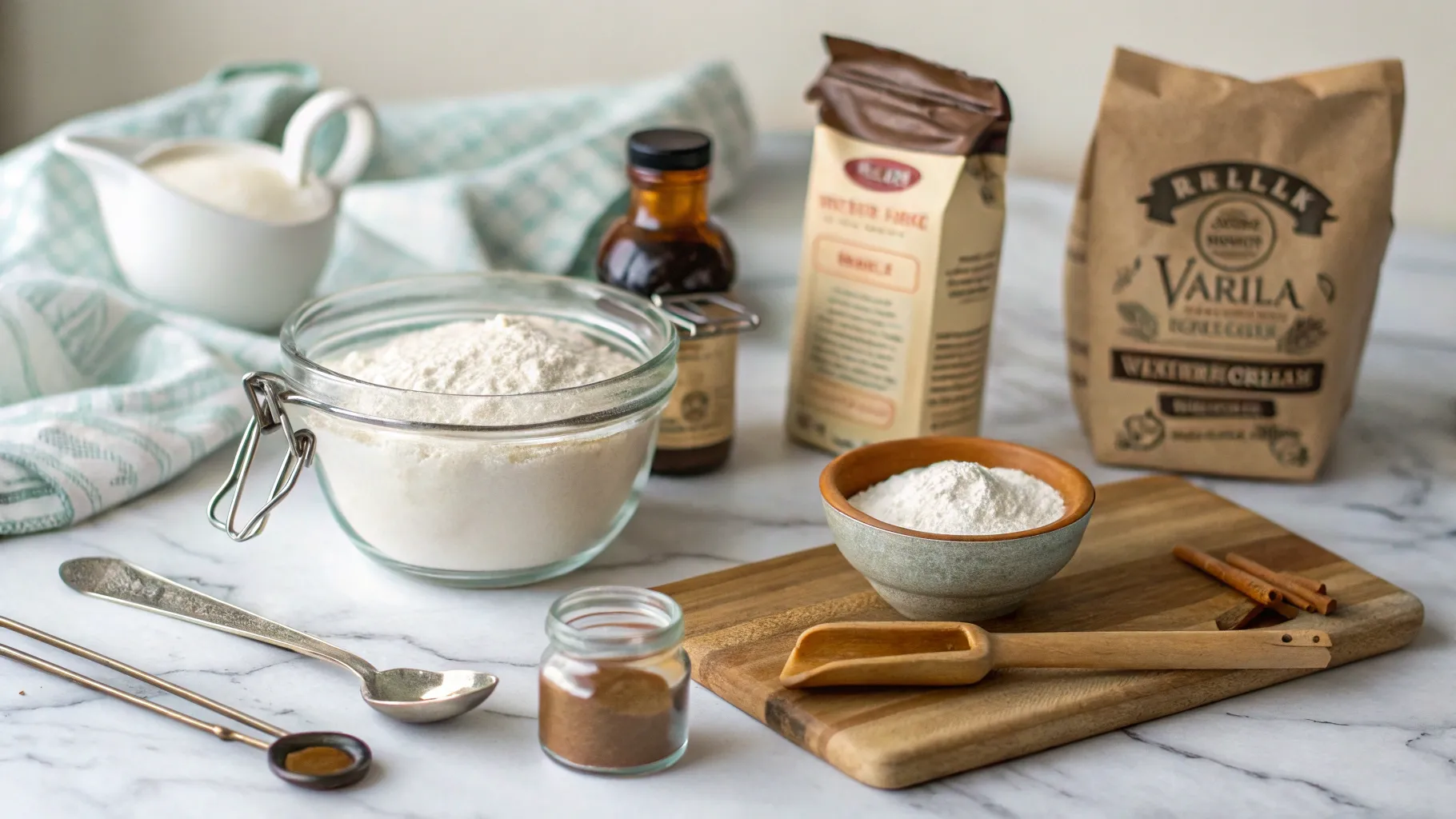
Spices & Seasonings
Spices are the soul of any kitchen, they turn simple ingredients into delicious, flavorful meals. Whether you’re roasting vegetables, seasoning proteins, or simmering a pot of soup, the right spice can elevate your dish from bland to bold. For new cooks, stocking a basic spice rack is one of the smartest ways to unlock flavor without complicating your cooking.
To learn more about spices, be sure to check out The Beginner’s Guide to Spices, and to truly master the seasoning game, don’t miss our tips in Mastering Food Seasoning.
Here’s a breakdown of essential spices and seasonings every beginner should keep on hand, plus smart ways to use them to elevate your everyday cooking.
1. Salt & Black Pepper
These two are the foundation of seasoning:
- Salt enhances natural flavors, balances sweetness, and reduces bitterness.
- Black pepper adds gentle heat and earthy complexity.
💡 Pro tip: Use kosher salt for cooking and table salt for baking. Freshly ground black pepper is more aromatic and flavorful than pre-ground.
2. Garlic Powder & Onion Powder
These powdered alliums are staples for easy, everyday flavor:
- Garlic powder brings savory depth to rubs, soups, and marinades.
- Onion powder adds a sweet, mellow onion flavor to sauces, burgers, or roasted vegetables.
Great when you don’t have fresh garlic or onions on hand.
3. Paprika (Smoked or Sweet)
Paprika adds color and mild flavor to countless dishes:
- Sweet paprika is versatile and subtle, use in stews, eggs, and rice.
- Smoked paprika brings a rich, smoky note to grilled meats, roasted veggies, and dips like hummus.
4. Chili Powder or Red Pepper Flakes
If you like a little kick:
- Chili powder (a blend of spices) is perfect for tacos, chili, and Tex-Mex dishes.
- Red pepper flakes are ideal for pizza, pasta, and stir-fries.
Add gradually, spice builds quickly!
5. Cumin
Cumin has a warm, earthy aroma often used in:
- Mexican, Indian, Middle Eastern, and North African cooking.
- Try it in ground beef, bean dishes, lentil soups, and chili.
Toasted cumin seeds add extra flavor, just heat them in a dry skillet before grinding or using.
6. Cinnamon
Cinnamon isn’t just for sweets!
- Use in oatmeal, cookies, and muffins.
- Also adds depth to Moroccan tagines, spiced stews, and chili.
Keep both ground cinnamon and cinnamon sticks if you enjoy warm drinks or mulled cider.
7. Oregano or Italian Seasoning
- Oregano is earthy and bold, great for pasta sauces, roasted potatoes, and grilled chicken.
- Italian seasoning blends oregano, basil, thyme, and rosemary, a convenient all-in-one mix for pizza, marinades, and tomato dishes.
8. Curry Powder or Turmeric
- Curry powder is a warm, complex blend perfect for curries, rice, and chickpeas.
- Turmeric adds a golden color and subtle bitterness. It’s also known for anti-inflammatory benefits and is used in Indian, Thai, and Middle Eastern recipes.
Both are great for experimenting with global flavors.
How to Store Spices Properly
To preserve freshness and flavor:
- Store spices in airtight jars in a cool, dark place (not above your stove!).
- Avoid heat, light, and humidity, they cause spices to lose potency faster.
- Label with purchase dates and replace ground spices every 1–2 years for maximum flavor.
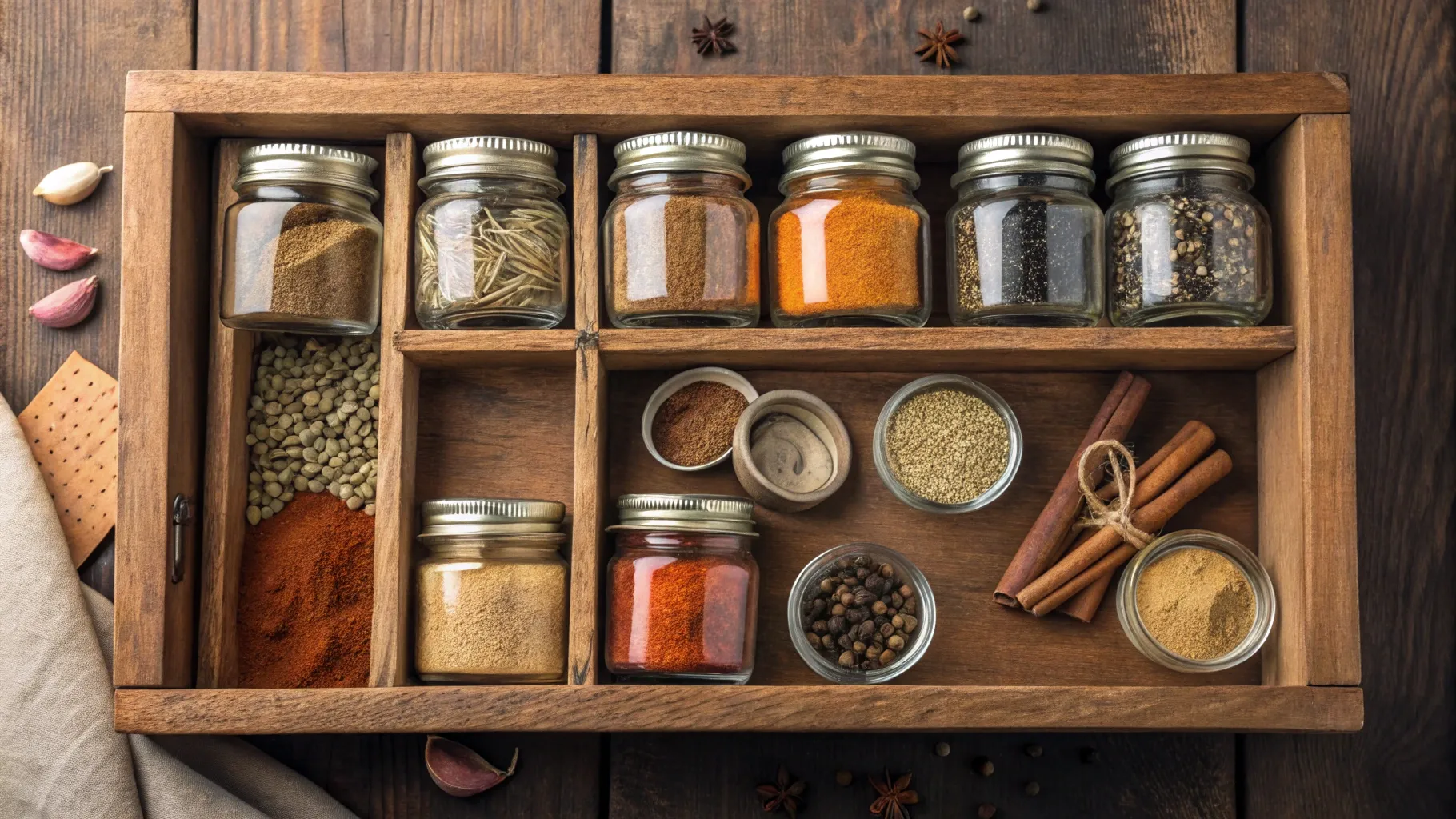
Oils, Vinegars & Condiments
No pantry is complete without a selection of oils, vinegars, and flavorful condiments. These multipurpose ingredients are the secret weapons behind marinades, dressings, glazes, dips, and stir-fries. They add richness, acidity, tang, sweetness, and umami, often with just a drizzle or spoonful.
Whether you’re making a vinaigrette, searing vegetables, or finishing a dish with flair, here are the staples every new cook should have:
1. Olive Oil
A must-have for everyday cooking and finishing:
- Use for sautéing, roasting, and especially for salad dressings or drizzling over finished dishes.
- Look for extra virgin olive oil (EVOO) for the best flavor, grassy, peppery, or fruity depending on the variety.
💡 Storage tip: Keep olive oil in a dark glass bottle or inside a cabinet away from heat and light to prevent oxidation and bitterness.
2. Vegetable or Canola Oil
These neutral-tasting oils are perfect for high-heat cooking:
- Use for frying, baking, and grilling.
- Their subtle flavor lets your other ingredients shine.
- Also great for recipes that don’t need olive oil’s assertiveness, like muffins or stir-fries.
📝Note: They’re affordable and have a long shelf life.
3. Soy Sauce
Soy sauce adds saltiness, umami, and depth, especially in Asian-inspired dishes.
- Use in stir-fries, marinades, dipping sauces, or even salad dressings.
- Keep both regular and low-sodium varieties if you’re watching your salt intake.
Also try tamari (a gluten-free version) or coconut aminos as alternatives.
4. Balsamic or Red Wine Vinegar
Vinegars are essential for balancing flavors and brightening dishes.
- Balsamic vinegar: Slightly sweet and syrupy, perfect for glazes, salad dressings, and roasted veggies.
- Red wine vinegar: Sharper, tangy, and versatile, great in vinaigrettes, sauces, or marinated onions.
Also consider adding white wine vinegar or rice vinegar for more variety later on.
5. Apple Cider Vinegar
A pantry favorite for both health and flavor:
- Use in slaws, pickles, marinades, and vinaigrettes.
- Adds a mild fruitiness and pairs well with honey or mustard.
It’s also used in baking (as an acid to activate baking soda) and even in some natural cleaning solutions.
6. Hot Sauce
A little heat can go a long way in elevating your dish:
- Keep a bottle of your favorite hot sauce or chili sauce handy for eggs, tacos, soups, or marinades.
- Popular choices include sriracha, Tabasco, and chipotle sauces.
💡 Pro tip: Try mixing hot sauce with honey for a sweet-spicy glaze.
7. Mustard & Ketchup
Classic condiments with far more uses than burgers:
- Mustard adds sharpness and emulsifies dressings or marinades. Dijon and whole grain are especially versatile.
- Ketchup is great for dipping, but also forms the base for BBQ sauces and meatloaf glazes.
8. Honey or Maple Syrup
Natural sweeteners to balance acidity and spice:
- Add to sauces, dressings, marinades, and baked goods.
- Honey is antimicrobial and soothing, great for tea, toast, and glazes.
- Maple syrup pairs beautifully with mustard or soy sauce for roasted veggies or grilled meats.
Pantry Tip:
- Store oils and vinegars in cool, dark places, tightly sealed to prevent oxidation or contamination.
- Check expiration dates periodically, especially on opened condiments and vinegars.
- Shake or stir condiments that separate naturally (like mustard or hot sauce) before using.
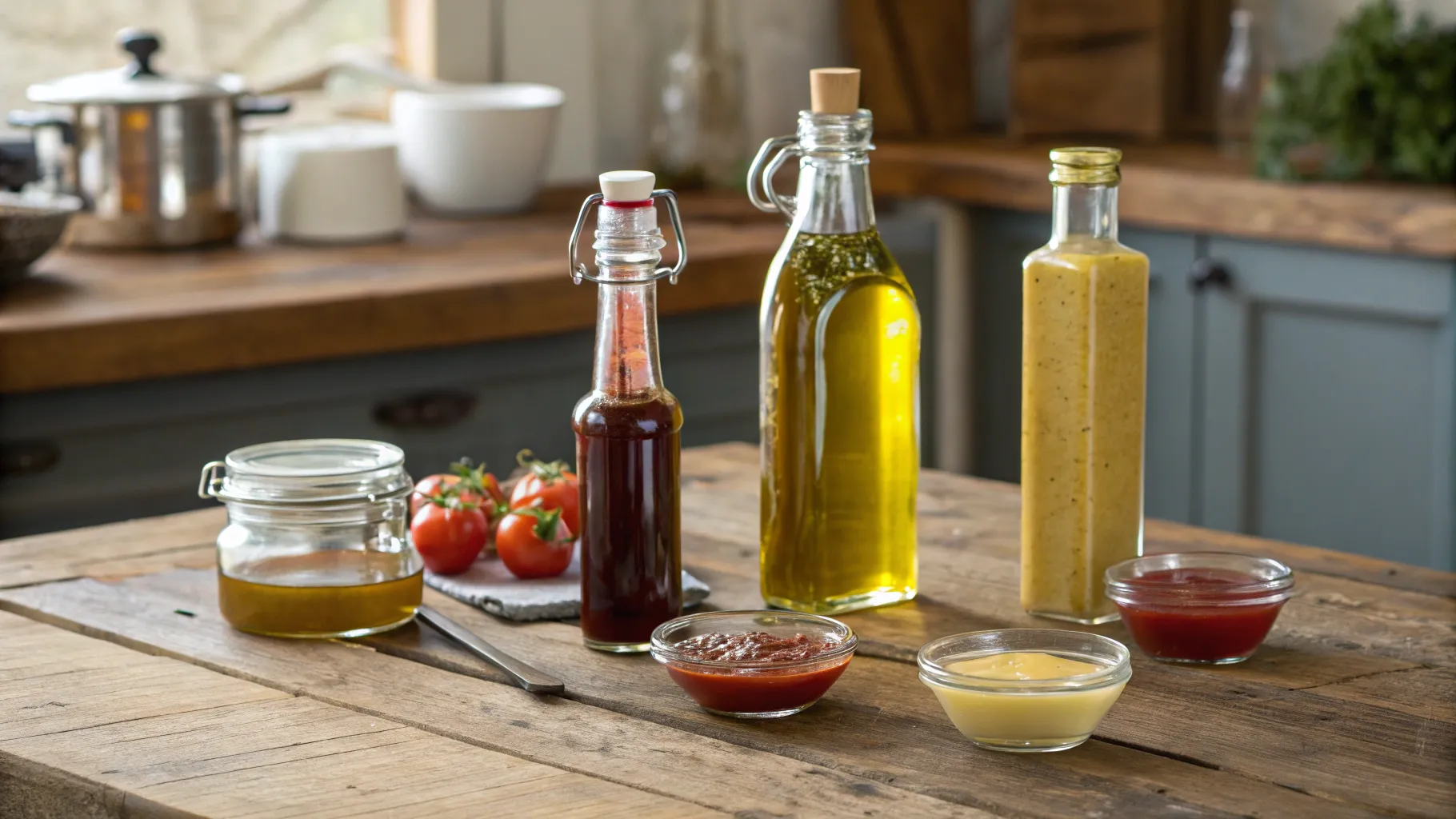
Nut Butters, Nuts & Seeds
Great for snacks, sauces, and baking.
- Peanut butter or almond butter
- Chia seeds or flaxseeds
- Almonds, walnuts, or mixed nuts
- Sunflower seeds or pumpkin seeds
💡 Pro tip: Store nuts and seeds in the fridge or freezer to extend shelf life.
Snacks & Extras
A few pantry-ready snacks and extras will keep you energized between meals or help complete a dish.
- Crackers or rice cakes
- Granola bars or trail mix
- Dark chocolate or baking chips
- Popcorn kernels
Optional Add-ons:
- Canned soups
- Instant noodles or ramen
- Jarred pickles or olives
- Shelf-stable plant-based milks (almond, oat, soy)
Pantry Organization Tips for Beginners
Keeping your pantry organized and your foods stored properly isn’t just about aesthetics, it’s a smart way to save time, reduce waste, and cook with confidence. A well-organized pantry helps you find ingredients quickly, keeps staples fresher longer, and allows you to focus more on creating great meals rather than digging through clutter.
Be sure to check out our tips on How to Store Food Properly to make the most of your pantry staples and keep everything in top shape.
Here are simple, beginner-friendly tips to help you set up and maintain a clean, efficient, and easy-to-navigate pantry:
1. Label and Date Everything
Whether you’re transferring ingredients into containers or storing bulk items from the grocery store, labeling is key:
- Write the name of the item and the date you opened or purchased it.
- Use erasable markers, chalk labels, or printable stickers to make updates easy.
- Dating helps you use up ingredients before they expire, especially important for flours, nuts, and spices.
2. Use Clear Containers
Clear, airtight containers aren’t just aesthetically pleasing, they’re practical:
- You can see exactly how much you have left, making it easier to plan grocery lists.
- Airtight containers keep moisture and pests out, helping grains, flours, and snacks stay fresher longer.
- Opt for stackable bins or jars to maximize shelf space.
3. Store Most-Used Items at Eye Level
Reserve your most accessible shelf for everyday essentials:
- Keep frequently used ingredients like rice, pasta, oil, salt, and spices within easy reach.
- Place lesser-used items (like baking supplies or specialty condiments) on higher or lower shelves.
- This setup makes daily cooking smoother and prevents “pantry blind spots.”
4. Keep a “Use Me Soon” Bin
Designate a basket or bin for items that need to be used up soon:
- Include near-expiry sauces, open packages, or single servings of snacks.
- Label it clearly and check it first when meal planning or cooking.
- This system helps reduce waste and makes sure older food doesn’t get forgotten behind newer items.
5. Review & Refresh Every 2–3 Months
Doing a seasonal check-in with your pantry helps keep things fresh and functional:
- Toss expired or stale items.
- Wipe down shelves to avoid sticky spots or crumbs.
- Take stock of what you’ve used most and what’s just taking up space.
- Refill any basics like flour, beans, pasta, and spices.
💡 Pro tip: Use this time to reorganize shelves if needed, maybe you’re cooking more international dishes now, or baking more often!
With just a little attention, your pantry can go from chaotic to curated, giving you a clearer view of what you have and inspiring more creative (and less stressful) cooking. Whether your space is a single shelf or a full walk-in, smart organization makes all the difference.
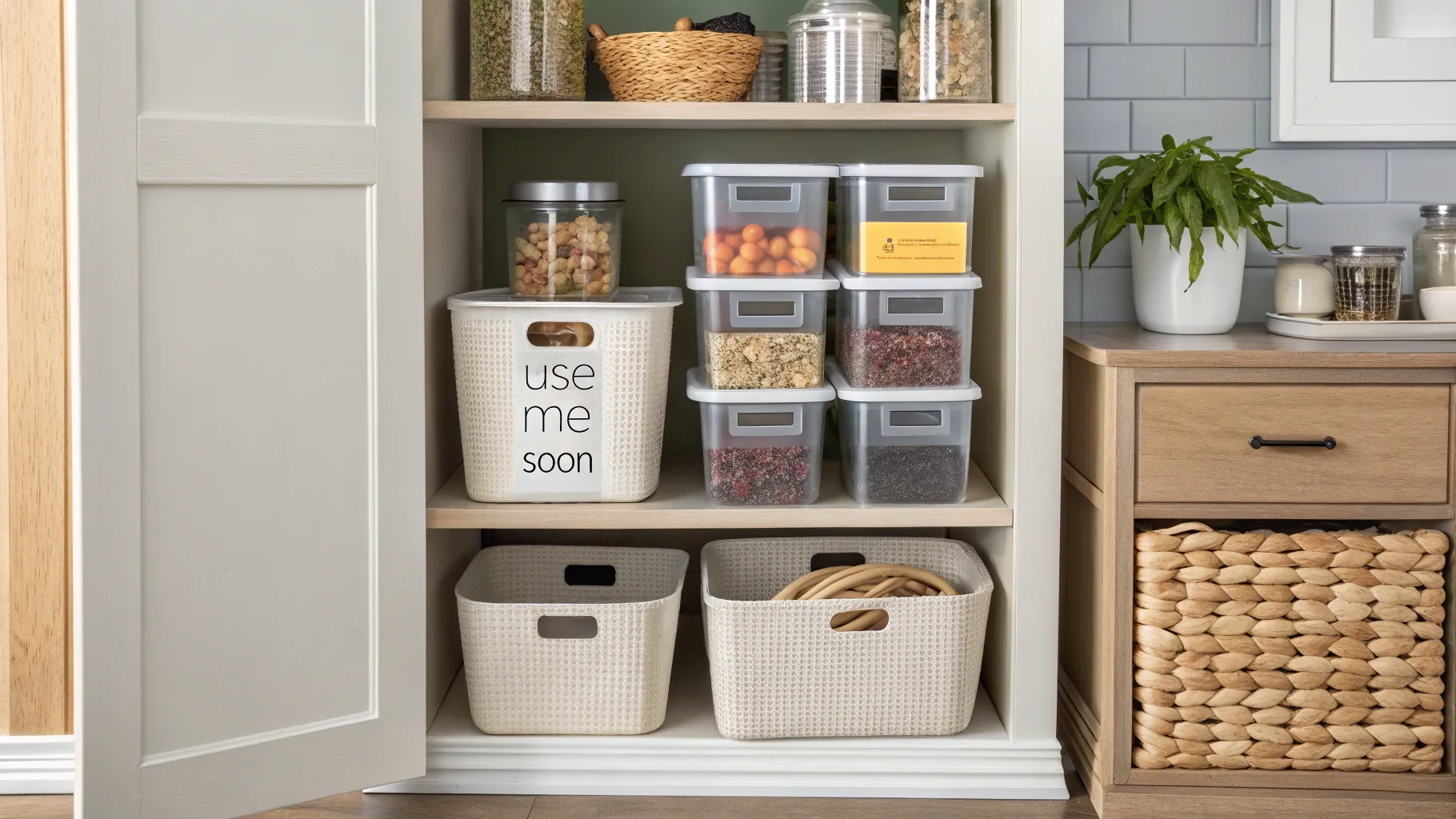
Beginner Pantry Checklist (Quick Summary)
| Category | Essentials |
|---|---|
| Grains | Rice, pasta, oats, quinoa |
| Canned goods | Beans, tomatoes, tuna, broth |
| Baking | Flour, sugar, baking powder, vanilla |
| Spices | Salt, pepper, garlic powder, cumin, paprika |
| Oils & vinegars | Olive oil, vinegar, soy sauce, hot sauce |
| Nut & seeds | Peanut butter, almonds, chia seeds |
| Condiments | Ketchup, mustard, honey |
| Snacks | Crackers, granola bars, dark chocolate |
Final Thoughts: Build Your Pantry, Build Your Confidence
Your pantry is the secret to stress-free, spontaneous, and satisfying cooking. Stocking the basics means you’ll always have what you need to throw together a quick meal, try a new recipe, or reinvent leftovers into something great.
Start small, build gradually, and tweak based on your personal cooking style. Over time, your pantry will become as much a reflection of you as your favorite dish.
💡 Enjoyed this post?
Follow us for daily kitchen tips and tasty inspiration!
📌 Pinterest | 📘 Facebook | 📸 Instagram

